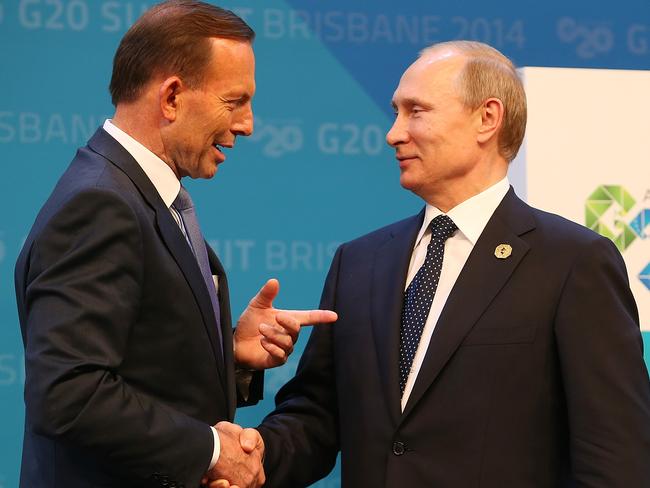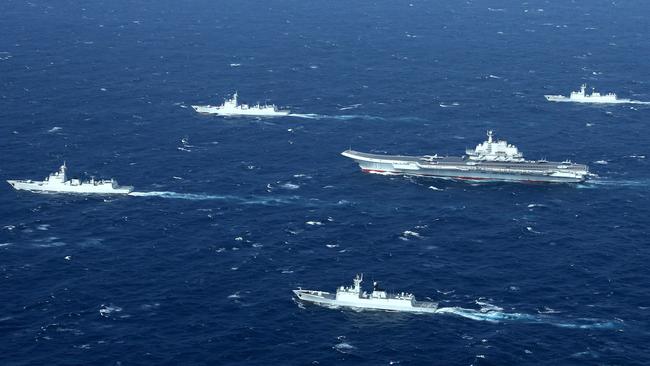Chinese fleet is bringing troubled waters close to home
TONY Abbott revealed Australia’s inability to counter Russian ships off the Queensland coast in 2014. With Chinese ships surging into the Indian Ocean, can we do any better now?

National
Don't miss out on the headlines from National. Followed categories will be added to My News.
NEW Delhi has expressed alarm at a ‘surge’ of Chinese warships and submarines into the Indian Ocean. And it could repeat a recent embarrassing problem for Australia’s defence force.
A report in the newspaper India Todaysays Beijing, in an ‘aggressive move’, has deployed a conventional diesel-electric submarine of the Yuan class to the Indian Ocean, joining a growing fleet of 14 warships and support vessels.
This is up from just three in 2014.
And the presence of such a force within Australia’s ‘sphere of influence’ presents a diplomatic, posturing and surveillance problem on a scale not seen since the forays of French, American and Russian fleets in Colonial times.
As the alarm bells ring in New Delhi, should Canberra be positioning itself to confront a major shift in the regional balance of power?
POWER PLAYS
Former Prime Minister Tony Abbott last week lashed out at the state of Australia’s defence force, saying our conventionally-powered Collins class submarines had been unable to ‘shadow’ a task force of Russian warships when they appeared off Queensland during the 2014 G20 summit.
Just a month earlier Mr Abbott, then Prime Minister, had threatened to “shirt-front” Russian President Vladimir Putin over the downing of Malaysian Airlines Flight MH17.
Instead, it was Australia which had its composure ruffled when the Russian warships unexpectedly appeared. Frantic diplomatic efforts were launched in Moscow to establish Putin’s intentions.

Such a flexing of muscles, given increasing territorial tensions in the South and East China Seas and Beijing’s growing naval presence in the Indian Ocean, may soon be back on the cards.
The bluster’s already there.
Beijing last year warned “‘Paper cat’ Australia will learn its lesson” after speaking out in support of The Hague’s ruling against its territorial claims in the South China Sea. It asserted Canberra should keep out of China’s affairs, and challenged Australia’s claims to rights over the Antarctic continental shelf.
And its increasing presence in the Indian Ocean may enable Beijing to back up any future diplomatic sabre-rattling with a Putin-like display of warship power off our coast.
EXPANDING BELT
Executive Director of the Australian Strategic Policy Institute (ASPI) Peter Jennings says there has been a substantial increase in extended Chinese naval deployments throughout the Indian Ocean region and the Pacific.
“The PLA-N [People’s Liberation Army-Navy] is everywhere in much bigger numbers ...” Jennings says. “Their presence is relatively new, pervasive and disturbing to other countries.”
Three years ago, the Chinese navy sent warships through Sunda Strait, between the Indonesian islands of Java and Sumatra, for the first time. The ships passed close to Australia’s Christmas Island.
ASPI senior analyst Dr Anthony Bergin adds that such ‘showing the flag’ exercises will only become more common.

EXPLORE MORE: China’s carrier fleet set to muscle its way into Asia
“China is developing a naval access facility at Djibouti. It’s likely to develop a fully-fledged naval base at Gwadar. With ‘one belt one road ‘ it is probable that the PLA navy will turn the port there into a long term base for its Indian Ocean operations,” Dr Bergin says.
They’re also watching the Indian Ocean naval exercises of other countries
“China also has an active intelligence gathering capacity at sea both with PLA vessels and ‘scientific research boats’ that routinely turn up at RIMPACs,” Mr Jennings says. “ I wouldn’t be at all surprised if we don’t see one turn up to watch the (current) Talisman Sabre exercise.”
He adds that Australia would also be watching them, in turn, “by all manner of means from over the horizon radar to the P-3 Orions and other technologies.”
While Dr Bergin says he is unaware of any Chinese naval activity in the Southern Ocean so far, Beijing does send its two icebreakers into Antarctic waters to undertake ocean floor mapping.
But he says the close co-ordination between the Chinese military and its State Oceanic Administration means “we will see further involvement of China’s military in their Antarctic program”.
INDIA UNDER PRESSURE
India’s expressions of concern over China’s naval presence comes in the context of a recent serious border clash. Beijing’s unilateral decision to build a military-grade road into disputed territory between India, Bhutan and China sparked a new standoff late last month.
“We must acknowledge that India-China relations are undergoing a change,” a column published earlier in India’s The Tribune reads. “China believes that India should acknowledge the power disparity between the two sides and show appropriate deference to China. In the past it had tacitly acknowledged Indian pre-eminence in the South Asian region. It is no longer willing to do so and is seeking such pre-eminence for itself.”

Dr Bergin says there’s little surprise China’s recent submarine movements have been met with alarm by New Delhi, he says.
“The deployment of Chinese SSNs in the Indian Ocean threatens India’s submarine-based nuclear-weapon bastion. It impinges upon the survivability of India’s nuclear deterrence.”
Indian media is highlighting the arrival of a Yuan-class diesel-electric submarine in the region, as well as the presence of the electronic surveillance ‘spy ship’ Haiwngxing.
“Indian assets picked up the submarine entering the Indian Ocean Region recently,” India Today reported earlier this week. It quotes unnamed defence sources as saying the spy ship is monitoring the annual India-US-Japan Malabar naval exercise.

“From a modest beginning of a flotilla of just three warships — two destroyers and a support ship — in 2013-14, more and more Chinese warships are prowling in the waters around India.”
It says Indian satellites and surveillance assets have detected 14 Chinese naval vessels in the Indian Ocean Region — including some of Beijing’s most modern ‘stealth’ destroyers and frigates.
But the greatest shock came in December 2013, when a nuclear-powered attack submarine spent almost three months in waters around the subcontinent.
Since then there have been several more deployments of conventional and nuclear powered submarines, including a Han class nuclear attack vessel last year.
“Worryingly for India, the increased warship deployment goes hand-in-hand with the deployment of Hydrographic, Oceanographic vessels and spy-ships in the Indian Ocean to map the sea bed,” the paper reports. “Bathymetric data among other things detail how currents and noise behave at particular depth, the lay of the ocean floor are critical for submarine deployments.”



